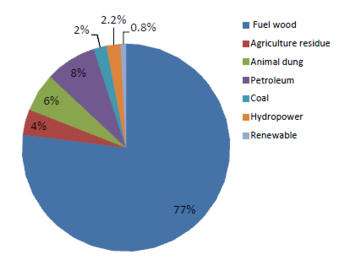Click here to register!
Difference between revisions of "Energy Provision in Rural Areas of Nepal"
***** (***** | *****) (Created page with " [[File:Hohenheim Summer School Banner.png|center|800px|International DAAD-Alumni Summer School|alt=International DAAD-Alumni Summer School|link=International DAAD-Alumni Summ...") |
***** (***** | *****) |
||
| Line 14: | Line 14: | ||
= Introduction = | = Introduction = | ||
| − | Nepal is a country of the Himalayas. There are many mountains in Nepal. Nepal is located inSouth Asia in between two | + | Nepal is a country of the Himalayas. There are many mountains in Nepal. Nepal is located inSouth Asia in between two bigemerging countries India and China. Nepal has population of 30million. About 70% of population resides in rural areas whereas only 30% are urban residents.The majority of population in Nepal has still no access to quality energy. Despite having highpotential of solar, hydropower, biomass resources the country’s energy mix situation is heavilypredominant by traditional source of energy. |
<br/> | <br/> | ||
| − | + | [[File:Energy Provision Nepal.png|thumb|center|350px|Energy Mix Situation in Nepal (Source: Economic Survey of Nepal, Ministry of Finance, Government of Nepal, 2012,Kathmandu]] | |
| − | |||
| − | |||
| − | |||
| − | |||
| − | |||
| − | |||
| − | |||
| − | |||
<br/> | <br/> | ||
Revision as of 20:55, 25 February 2014
Introduction
Nepal is a country of the Himalayas. There are many mountains in Nepal. Nepal is located inSouth Asia in between two bigemerging countries India and China. Nepal has population of 30million. About 70% of population resides in rural areas whereas only 30% are urban residents.The majority of population in Nepal has still no access to quality energy. Despite having highpotential of solar, hydropower, biomass resources the country’s energy mix situation is heavilypredominant by traditional source of energy.
Traditional way of using fuel wood for cooking, heating is affecting the health of women andchildren in rural areas. Moreover, the deforestation rate is high due to dependency on forest forfuel wood. The quality of life of people in rural areas can improve only there would be provisionof clean energy. The huge potential of untapped renewable energy resources need to explore toprovide financially viable energy solution to the rural people in Nepal. Now, with the financialand technical assistances from donors and international community the awareness is increasingon renewable technologies appropriate for rural areas. Some of the technologies which arealready dispersed in remote Nepal are Solar PV, Solar Parabolic Cookers, Solar dryers,Micro/mini hydro, Improved Cooked Stoves (ICS), household biogas. Pictures from rural Nepalare as follow. Other more pictures from rural Nepal will be presented in the Summer School.
Further Information
- EnDev Nepal Micro Hydropower Debt Fund Component
- Community Rural Electrification Programme (CREP) Nepal
- Biogas Technology in Nepal
References






















